NATURE INSPIRED INVENTIONS --- Dams; and man stooped to learn from the little engineers of the animal kingdom.
In the early times, the major reason why man built dams was mainly for the purposes of irrigation his plant and water supply. But as man became more civilized, he began to use the dam for other purposes like flood control, sediment control, energy generation, navigation e.t.c.
Right now, it is almost impossible to imagine a world without the dam, as its benefits includes both economic and domestic, and a single dam can serve more than one purpose. If I were to ask any of us were Katherine Herzer got the idea from, 90 % of us won't get it right. In fact, most of us would answer that the idea came from idesd. But that's not true.
Just as most of man's invention, man got the idea on the importance and also how to build the dam from nature. It is from the beaver that man got this wonderful idea from. When man went to learn from the beavers, the beavers, as good engineers they are didn't just teach man the importance of the dam, You could include looking for theses dams amonsgt , they also taught man step by step on how to build the dam so as to prevent it from failing.
In this article, we will be considering what a dam is, we will also get to know what a beaver is, how beavers build their dams, and how man applied all he learnt from them in building his own dams.
DAM
Dams are regarded as barriers whose purpose is to prevent or restrict the flow of water or underground streams. Dams are simply reservoirs, and since reservoirs prevent the flow of water, they are of great importance in suppressing floods, as flood water can be made to flow into it and not cover up the land. Dams are also used to store water needed for activities like irrigation, aquaculture, navigation and even for providing the water needed for human consumption and industrial use.
A dam maybe built to fulfill only one of this function, while some can be built to perform more than one function.
For this reason, we regard certain dams as single purpose, while others we regard as multipurpose. One of the crucial uses of dam is in hydropower. Here, dams help in the generation of electricity. In all these, it is worth noting that the main purpose of dams is for retaining water.
It is not surprising that even the dam isn't an invention man came up with by just thinking. The beavers, whom man got the idea from have been building dams for centuries. Let us get to know a little about this animal, and how it builds it's dam.
BEAVERS
Beavers are the largest rodents in the North America, and the second largest in the world. They are found throughout North America, apart from places like the desert southwest, northern part of Alaska and Canada, central and southern Mexico, and most of Florida. Probably one of the most interesting animals in the world, the adult rodent weigh over 60 pounds and can be as long as four feet. Beavers can live up to 20 years.
Characteristics of beaver
Beavers can be easily distinguished from other rodents by the fact that they have large, but flat and nearly hairless tails. Also, their hind feet are webbed, and they use this webbed feet to propel themselves through the water. Their tails are of great importance, as they don't only use it for maintaining balance while they gnaw on trees, they also slap it against the water to signal to others whenever there is a predator close by.
Beavers are built to survive under water, when they are under the water, a special membrane closes both its nose and ears. The beaver secrets a special oil called castoreum from its scent glands. With this castoreum, it waterproofs' it's thick fur, thus it doesn't get wet under water. I guess you must be wondering why beavers don't get too cold while underwater since they are warm blooded, The reason why they don't die of cold while under water is because of the thick layer of fats under their skin that keeps them warm. Beaver do also have sharp teeth that grow throughout their lives. They make use of it in cutting into woody vegetation and trees.
What they feed on
Beavers feed majorly on cambium and bark of trees like cottonwood, beech, alder trees, poplar, birch, willow, maple, aspen trees e.t.c. Their digestive system is specially built to be able to digest bark of trees. They also feed on roots and buds and other water plants.
Habitat:- Lodges
Beavers are known to live very close to the rivers, ponds, lakes, and even marshes. Close to the pond bank or lake shores, they build lodges, using sticks and mud. These lodges are their homes, and at the end of each autumn, the beaver covers their lodge with fresh mud. This fresh mud freezes when frost arrives, thus making the lodge so strong, even to the extent that they can't be penetrated by wolves and wolverines. The beaver build their lodges so as to have one or two entrances and vent making the lodge airy. The doors of the lodges are built a bit high above the water.
BEAVER DAMS
Despite all these wonderful characteristics of the beaver, none is as amazing as the dams beavers make. These dams are built by beavers so as to create a pond that would act as protection against it's predators (e.g wolves, coyotes, and bears). (Note:- If where they are is surrounded by water, they need not build a dam). Since beavers love being in water, these dams also provide access to food for them during winter. Beavers are very hardworking creatures as they can walk all night, carrying stones, timbers and muds needed for the building of these dams with the help of their teeth and fore paw.
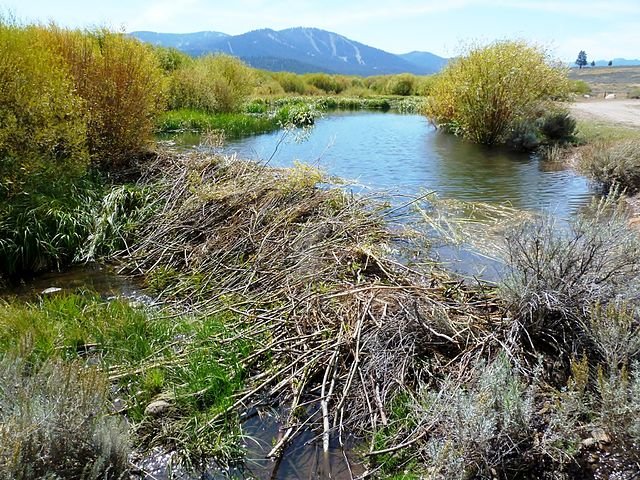
Picture by Schmibel - Wikicommons CC BY-SA 3.0
A beaver dam
HOW BEAVERS CONSTRUCT THEIR DAMS
During the construction of the dam, the first thing the beaver does is to divert the stream, making the stream to flow in another direction away from where they want to build the dam, thus reducing the flow pressure in the area. Beavers are able to transport their own weight of mud, sticks e.t.c. All they need to do is to drag them along. Using their paw and their teeth, the trees branches and logs, even the mud needed to build the dam are transported to the building site. Those branches and logs are driven deep inside the mud of the stream bed so as to form the base of the dam.
After that, the beaver uses barks from deciduous trees, rocks, grasses, mud, leaves from plants and anything else they can lay their fore paws on to build a wonderful structure. The height of the least dam a beaver builds is around 5.9 feet (1.8m), and the thickness of the dam structure is about 1m. The length of a dam is totally dependent on the width of the stream, but in average, it's about 4.5m long. Cases beavers building a dam of 12 feet high and 275 feet long have been heard of. You can check it out here.
It is worth noting that the beavers do not build just a type of dam, the type of dam they builds is totally dependent on the speed of the water. If the water is a slow moving water, they build a straight dam, but when it is a fast moving water, they build a dam that is curved. It is amazing that they put into consideration stuffs that only highly intelligent beings can think of by creating spillway and passageways in the dam, so as to enable excess water to drain of the dam without damaging the dam. They also make the dams wilder at the top and at the base so as to make it to be able to resist the force of the water current.
The size of the tree that a beaver uses to build it's dam can be as large as 90 centimetres in diameter, (though the average size is about 30 centimetres), but it is worth noting that the size of the tree used is totally dependent on the size of the beaver. Don't be amazed that I said that 90 cm diameter tree was felled by a beaver, we have heard of cases where a log that is 45 m tall and 115 cm in diameter was felled by a beaver. What it takes an average beaver to cut down a tree that is 15 cm wide is just 20 mins. In each bite it makes on a tree, a beaver cuts 1.5 cm off the sapling. Their jaws are very strong.
Beavers still think as humans, as the do carry out most maintenance work on their lodges and dams. The period of the year this maintenance is mostly done is during autumn.
We have learnt how beavers make dams let now consider the parts of dams that were built by humans and see if we won't find proof that man copied this invention from the beavers.
PS: Check out this article about Husband and Wife Reunited in Heaven Bible Verse from Scripture Savvy
PARTS OF A DAM
We will be considering 11 major parts of a man-built dam. Remember, we aim at seeking for similarities between it and those ones built by the beaver. Parts of a dam includes;
Crest:-
The top of a dam is what we refer to as the crest. Most times, the crest is built in such a way that it acts as a walkway or even a roadway over the dam.
Parapet Walls:-
At each side of the crest (which is used as a walkway or a roadway), lows walls are placed so as to prevent people from falling off the crest. Those low walls are what we know as parapet walls.
Heel:-
Just the same way the heel of a shoe touches the ground, the heel of a dam is the part of a dam that touches the ground or upstream side of the river bed.
Toe:-
We also have a part that is in contact with the ground or river bed at the downstream side. That part of the dam is known as the toe.
Spillway or passageway:-
It is logical to believe that if the water in the reservoir keeps piling up, a day will reach that it would exceed the boundaries. There is a passage already arranged to guide these excessive water away from the reservoir, we refer to those arrangements as spillway.
Diversion Tunnel:-
While the dam is been built, water is prevented from passing through it to avoid spoiling what is being built. For that reason, a diversion tunnel is built to change the direction of water, thus, by passing the site where the dam is being constructed.
Abutments:-
Abutments are the valley slopes on each side of the dam wall to which both the right and the left ends of the dam are fixed to.
Gallery:-
Gallery is like a gently sloping tunnel within the dam. It may be longitudinal or transverse and it always have drains on the floor for seepage water. The reason why they are made is to have a space for drilling drainage holes. They are also used to accommodate the instrument that would be used to study the performance of the dam.
Sluice way:-
The reason for the sluice way is to enable the clearing of silt that accumulates in a reservoir. They can be easily noticed in a dam, as they are those opening close to the base.
Free board:-
The space between the top of the dam and the highest level of water in the reservoir is the free board.
Dead Storage Level:-
This is the level of permanent storage, which if water gets below, it will not be drawn out.
I bet you saw similarities between the dam built by man and that built by beavers, as both do have to build a diversion channel before building the dam, and among many other similarities, both posses a spillway.
Let's now get to know the types of dams built by man.
TYPES OF DAM
We have so many types of dams but in this article, we will be concentrating on 8 (eight) of them which are commonly used in the world. They include:
Earth Dam:-
As the name insinuates, these type of dam are constructed using the soil. To prevent it from being eroded by water or wind, the dam is faced using crushed stone. Though it is made majorly using soil, it's spillway is made using concrete. The earth dam is quite strong, as the strength of the soil is enough to resist the forces that pushes against it.
Rock fill dam
These types of dam are made using large boulders and rock fragments. To avoid the seeping of water through the spaces between the rocks in the upstream side, an impervious membrane like the concrete is used to close those cracks. The rock-fill dam, logically is heavier than the heavier than the earth dam, as it is built using rocks, thus, its foundation should be stronger than that of the earth dam.
Arch dams
The arch dam gets its name from the fact that its entire structure is curved. Just as the curved structure of the beaver built dam, this arc has its convexity directed towards the upstream side. Arch dams are majorly used in canyons, especially those that has flanks that has enough strength to resist the pressure that is been produced by the arch of the dam.
Gravity dam
Gravity dams are very big in size and they are normally made using stones and concrete. This type of dam is design to be able to hold very large amount of water. Thus, no matter how much force the water exerts on the dam horizontally, it won't yield as the concrete used in making this dam gives it the strength it needs to resist this horizontal thrust. The peculiar thing about the gravity dam is that the water in it do not topple over. This is due to the fact that gravity holds the dam down to the ground. The name given to this dam is gotten from this above phenomenon.
Steel dam:-
Steel dams are made using steel, (as you rightly guessed). This dam is just a steel framework that has steel skin plates in its upstream side. We have two types of steel dams, which are the direct strutted and the cantilever steel dams. The cantilever steel has cantilever trusses, these trusses are those bent supports at its upper part. The direct-strutted dams on their own have inclinded struts, whose job is to directly transmit the pressure of the water to the dams foundation.
Buttress Dams
Buttress dams are normally triangular, and they have concrete walls that helps to transmit the pressure exert by the water on the slab to the foundation of the dam. We have three major types of buttress dams, which includes the massive head buttress dam, the multiple arch buttress dam and the deck buttress dam. Buttress dam can be distinguished from other types of dams based on the fact that they don't have solid wall that stresses across the river valley. Due to this particular feature, buttress dams are also referred to as hollow dams.
Timber Dams
Timber dams are made of wood, especially woods of trees like pines and fir and other coniferous timber. Timber dams are normally divided so as to have several openings. Each of this opening is covered using a wooden shield, placed in such a way that it can be lowered and raised anytime there is need to do so.
Rubber Dam
The rubber dam is the most recent type of dams. It consist of very huge cylindrical shells that are made using synthetic rubber. These shells are easily inflated by either using pressurized water or by compressed air. Rubber dams have limited use as they are only used for small projects.
IMPORTANCE OF DAMS
Dams are of great importance to humans as their use is not only for storing of water for human or agricultural use, it is also used for hydroelectric power, flood control, river navigation, recreation e.t.c. Let's consider these benefits of dams.
Recreation
One of the benefits of dam is that it indirectly provides facilities for recreational activities like boating, e. t. c. Recreational spots that have facilites for skiing, camping, boat lunch are supported majorly by dams.
Flood Control
Dams are used in preventing flooding from occurring. Flooding might result due to excessive rainfalls, and if there was no dam where these excessive water would flow into, it would result to loss of lives and properties. Thus, what the dam does is to store this excess water, later, it releases it into the river below, or divert this water to be used for other purposes.
Water Storage and irrigation
In places like the United States of America, dams acts as a water storage, and from there, the water needed for industrial, municipal and agricultural purposes (e.g irrigation) are supplied.
Power Generation
About 12% of the world's energy is from hydropower. Hydropower is always associated with dams, as the hydraulic turbines which produces the electric power needed are turned by the force of water. This hydropower is one of the clean renewable sources of energy as they don't cause ozone depletion, acid rain, or even air pollution.
CONCLUSION
No single thing living on earth can survive without water. Water is in fact the most important resource on earth apart from air. Every year, man's population grows steadily in millions, and with this growth in population, a corresponding growth in the demand of water. It is quite unfortunate that our freshwater resources is limited and unevenly distributed. Seasonal variations and climatic irregularities are not helping matters, as for no reason, a drought might occur and dry up all the waters in the water bodies in an area. Flooding itself, causes so much damages.
Man have always been plagued by these problems, till one day, a Katherine Herzer studied the behavior of the beaver, and learnt how it builds dam where ever it inhabits. That discovery lead to so many breakthroughs, as man no longer solely depend on water bodies for water, this time, he now able to store water and then use it during periods of drought when there is no water. This discovery also solved man's problem of losing his life and properties to flood, as all he had to do was to channel this excess flood water into his dam.
There are still yet so many things nature desires to teach man, some of them, she had already thought to little animals like the beaver we learnt today. I once told a friend that Nature has a school known as "Discovery", and she has gotten man to enrol in this school. Man just got admitted into the University of this great school, just take a look at what he has already achieved so far. You can imagine what man would have achieved by the time he get to his finals.
Till we meet again
REFERENCES
This article is spornsored by mechanicassistant.com

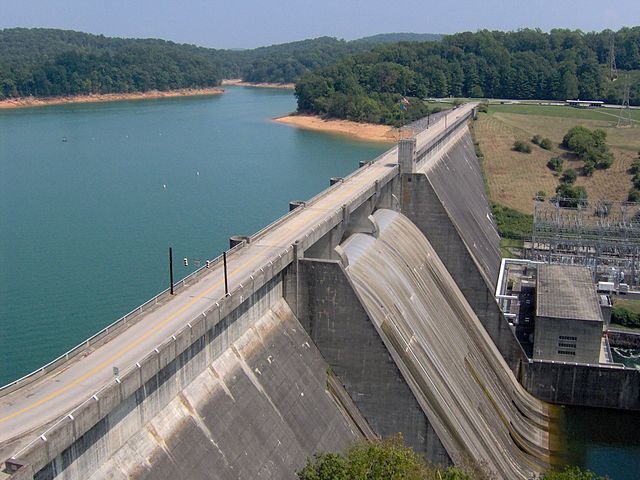


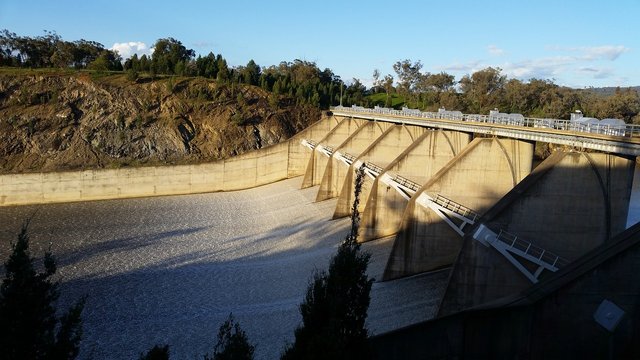
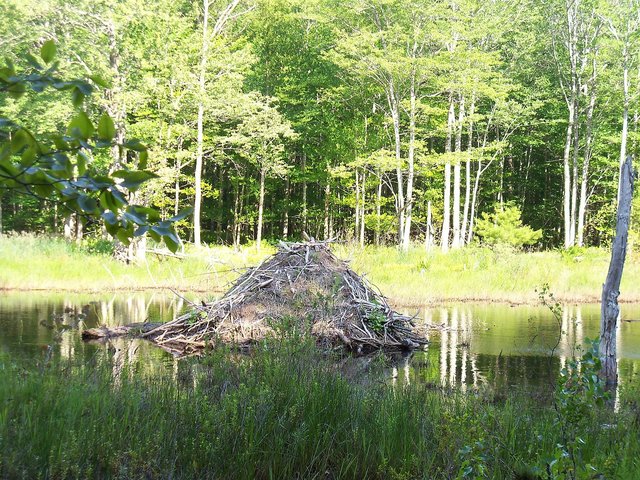
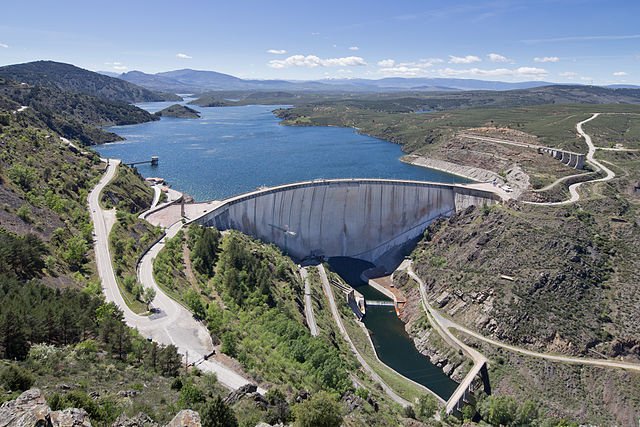
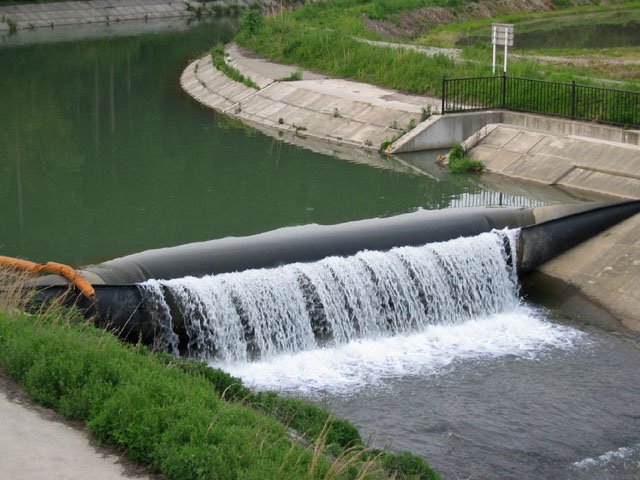
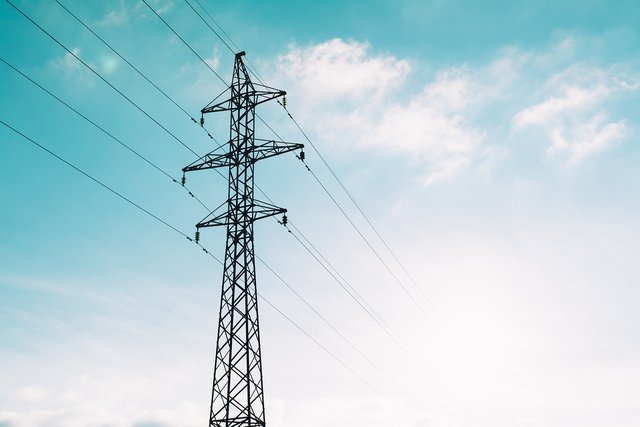

Amazing as always @whileponderin!
I had never realized the relation between beavers and dams.
I had no clue they did that, interesting little animals for sure :D.
The fact they design their dams according to the speed of water is surprising as well, I didn't expect they were as smart as taking that factor into consideration for their construction.
It must be very humbling for us the amount of things we can learn just by looking at different animals or insects.
Cheers @whileponderin!
It marvels me how these little animals (beavers) are very smart, up to the extent of putting into consideration things I thought only humans could put into consideration when building stuffs. Whenever I come across amazing behaviours like this, I can help but think that one of the lessons nature aims at teaching us is to be humble.. Am really glad you stopped by @dedicatedguy.
Just awesome. I didn't know anything about DAm but after reading this post, i think i can have a very long debate with anyone on DAM😂
I just become use to of reading your posts for enjoyment in my spare time. I get to learn a lot from each and every post of yours. Keep steeming
Lol. I just remembered when I wrote this post. it was after watching documentaries on beavers. What stood at to me wasn't the fact that they build dam, but the fact that they build different types of dams depending on the speed of the water! I was really astonished. That little piece of information was mind blowing. I knew that these little creatures need to be appreciated for their uncommon ingenuity. I knew I had to write about them.
Wow! you wrote that post for appreciating just that little creature. Your hard working and research behind that post is clear. And its marvelous how you spread the knowledge
keep writing those sort of post .MAy you get much success on steemit and outside steemit
Hi! This is jlk.news intelligent bot. I just upvoted your post based on my criteria for quality. Keep on writing nice posts on Steemit and follow me @jlkreiss to get premium world news updates round the clock! 🦄🦄🦄
Thanks
Congratulations! Your post has been selected as a daily Steemit truffle! It is listed on rank 10 of all contributions awarded today. You can find the TOP DAILY TRUFFLE PICKS HERE.
I upvoted your contribution because to my mind your post is at least 16 SBD worth and should receive 105 votes. It's now up to the lovely Steemit community to make this come true.
I am
TrufflePig, an Artificial Intelligence Bot that helps minnows and content curators using Machine Learning. If you are curious how I select content, you can find an explanation here!Have a nice day and sincerely yours,

TrufflePigHi @whileponderin!
Your post was upvoted by utopian.io in cooperation with steemstem - supporting knowledge, innovation and technological advancement on the Steem Blockchain.
Contribute to Open Source with utopian.io
Learn how to contribute on our website and join the new open source economy.
Want to chat? Join the Utopian Community on Discord https://discord.gg/h52nFrV